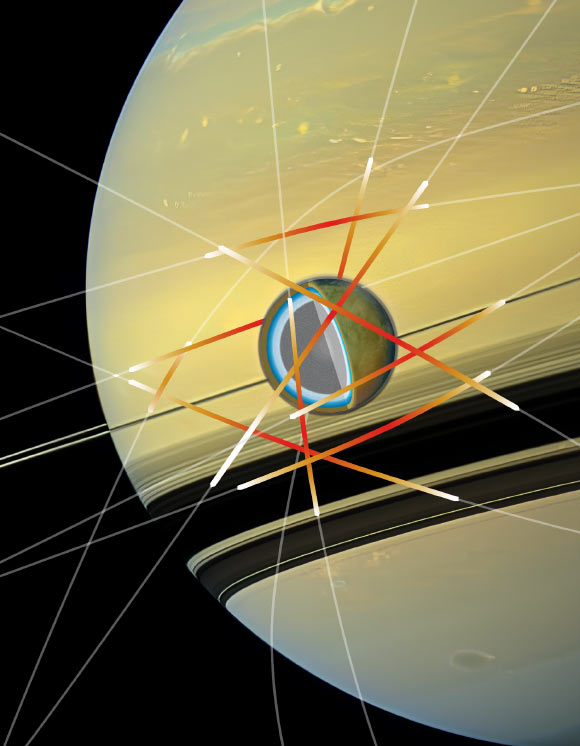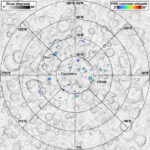Titan, the largest moon of Saturn, harbors an internal low-density ocean of water or ammonia, according to an analysis of archival data from NASA’s Cassini mission.
Representation of Cassini’s orbits used to calculate Titan’s gravity; the colored part of the orbits shows the distance from Cassini to Titan with the smallest distance in red; the cross-section of Titan shows the moon’s different layers with the ocean in blue; Saturn with rings and ring shadows can be seen in the background. Image credit: Britt Griswold, NASA’s Goddard Space Flight Center.
“Liquid water is one of the prerequisites for the emergence of life,” said Dr. Sander Goossens from NASA’s Goddard Space Flight Center and colleagues.
“Water is rarely liquid on the surface of a planet, but a number of moons in our Solar System, such as Titan, contain underground oceans.”
“These probably formed long ago, which raises the question of why they are not yet frozen in the cold environment far from the Sun.”
“Our study supports the explanation that ammonia extended the life of the liquid ocean in Titan. In addition, it provides insight into Titan’s deeper layers.”
NASA’s Cassini mission explored Saturn and its icy moons for more than a decade.
Among its many instruments, Cassini carried a radio science subsystem that enabled Earth-based radiometric tracking of the spacecraft by the Deep Space Network.
These data were used to determine the gravity field and interior structure of several of Saturn’s moons as well as those of Saturn itself. Cassini data were also used to determine Titan’s tidal response.
“The Cassini space mission flew around Saturn between 2005 and 2017,” the researchers said.
“To precisely measure Titan’s gravity, the spacecraft was sent close to the moon several times.”
“Cassini had to skim past Titan at exactly the right time to properly map the change in gravity.”
“This is because Titan’s deformation is due to Saturn’s tidal force, which depends on the distance between Titan and Saturn.”
“By measuring at times when Titan is close and far away from Saturn, the difference in Titan’s deformation and thus its effect on gravity was maximum.”
From precise radar measurements, the scientists calculated Cassini’s velocity and then the change in gravity and Titan’s deformation associated with it.
They carefully examined the effect of tides on Titan at each location in the spacecraft’s orbit and concluded that the deformation is smaller than previously calculated.
Numerical simulations of the moon’s deformation for different internal structures show that the most likely scenario is that the ocean has a density similar to that of water with a small proportion of ammonia.
“An underground ocean can help transport organic material from a moon’s rock core to the surface,” the authors said.
“For Titan, it was assumed that a thick ice layer between the ocean and the core made this difficult.”
“Our analysis suggests that the ice layer is possibly thinner than previously thought, making exchange of material between rock and the ocean more plausible.”
“The organic molecules that this can produce are seen as important ingredients for the emergence of life.”
The study was published in the journal Nature Astronomy.
_____
S. Goossens et al. A low-density ocean inside Titan inferred from Cassini data. Nat Astron, published online March 21, 2024; doi: 10.1038/s41550-024-02253-4




